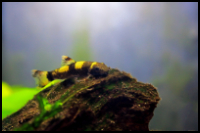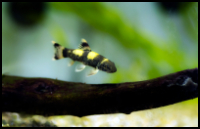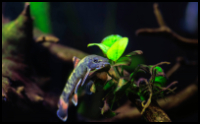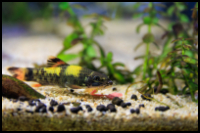





Quick Care Details (Table)
| Livestock Characteristics | Value |
|---|---|
| Care Level | Moderate |
| Temperament | Peaceful |
| Diet | Omnivore |
| Maximum Size | 4 Inches |
| Minimum Tank Size | 20 Gallons |
| Plant Safe | Yes |
| Temperature Range | 72-79°F |
| PH Range | 6.5-7.5 |
| KH Range | 4-8 dKH |
| GH Range | 4-12 dGH |
Species Specific Categories
Helpful Video
Care Details
Aquascape
- Provide a well-planted aquarium with plenty of hiding spots and caves.
- Use driftwood, rocks, and other decorations to create structure and hiding places.
- Leave open swimming areas for the fish to move around freely.
Substrate
- Use a fine-grained substrate such as sand or smooth gravel to prevent damage to the fish's delicate barbels.
- A dark-colored substrate can enhance the coloration and patterns of the Panda Garra.
Disease prevention
- Maintain excellent water quality through regular water changes and proper filtration.
- Quarantine new fish before introducing them to the main aquarium to prevent the spread of diseases.
- Avoid overcrowding and maintain suitable tank conditions to minimize stress and susceptibility to diseases.
Filtration
- Utilize a filtration system that provides efficient mechanical, chemical, and biological filtration.
- Aim for a moderate to strong flow rate to maintain good water circulation and oxygenation.
- Regularly clean and maintain the filter to ensure its optimal performance.
Lighting
- Provide moderate to low lighting conditions as the Panda Garra prefers subdued lighting.
- Use adjustable lighting options to replicate a natural day-night cycle.
Water Flow
- Panda Garra prefer gentle to moderate water flow in the aquarium.
- Use filters or adjust the flow rate to avoid excessive water currents that may stress the fish.
- Ensure sufficient oxygenation and water movement without causing discomfort to the fish.
Temperament and Behavior
Behavior
- Panda Garra are peaceful and social fish that generally get along well with other species.
- They are known for their playful and active nature, constantly exploring the aquarium and engaging in various behaviors.
- They may display some scraping or grazing behaviors on surfaces, such as rocks or decorations, as they feed on algae and microorganisms.
Breeding
- Breeding the Panda Garra in captivity is relatively rare and challenging.
- Little is known about their specific breeding requirements, as successful breeding has not been extensively documented.
- Simulating natural conditions, providing excellent water quality, and offering a varied diet may increase the chances of successful breeding.
Compatibility
- Panda Garra are generally peaceful and can be kept with a variety of peaceful fish species.
- Avoid housing them with aggressive or fin-nipping tankmates that may harass or stress them.
- Choose fish with similar water parameter requirements and temperaments to ensure compatibility.
Tankmates
- Suitable tankmates for Panda Garra include other peaceful community fish, such as tetras, rasboras, danios, or peaceful catfish.
- Avoid keeping them with aggressive or territorial species that may outcompete or harm them.
- Panda Garra are generally non-aggressive towards other fish, but keep an eye on their interactions to ensure harmony.
Activity Level
- Panda Garra are active swimmers and enjoy exploring their environment.
- They are known to exhibit playful behavior, often darting around the aquarium and investigating various surfaces.
- Providing plenty of hiding spots, caves, and open swimming areas will encourage their natural activity levels.
Clean up Crew
- Panda Garra can contribute to the clean-up crew in the aquarium by grazing on algae and microorganisms.
- They are known to help control algae growth, particularly soft green algae and diatoms.
- However, they may not completely eliminate all types of algae, and supplemental algae control measures may still be required in the tank.
Diet and Nutrition
Dry Foods
- Panda Garra readily accept high-quality dry foods such as sinking pellets, flakes, or granules.
- Look for foods specifically formulated for herbivorous or omnivorous fish species.
- Choose a variety of dry foods that offer a balanced nutritional profile and meet the dietary needs of the fish.
Frozen Foods
- Panda Garra can be offered a range of frozen foods, such as bloodworms, brine shrimp, daphnia, or cyclops.
- Thaw the frozen foods before feeding and ensure they are of high quality, free from any pathogens or contaminants.
Live Foods
- Live foods can be an occasional treat for Panda Garra and provide enrichment.
- Offer live foods like daphnia, brine shrimp, or blackworms, which can be a valuable source of protein and stimulate natural feeding behaviors.
- However, live foods should not be the sole diet as they may carry risks of introducing parasites or diseases to the aquarium.
Vegetables
- Panda Garra are considered omnivorous and can benefit from some vegetable matter in their diet.
- Offer blanched or lightly steamed vegetables such as spinach, zucchini, cucumber, or peas.
- Vegetables should be chopped into small, manageable pieces to ensure easy consumption.
Algae
- Panda Garra are known to graze on various types of algae in the aquarium.
- They can help control soft green algae and diatoms that may develop on surfaces.
- However, they may not consume all types of algae, and additional measures like proper lighting, nutrient control, and manual removal may be necessary to manage excessive algae growth.
Tank Parameters
Tank size
- A minimum tank size of 20 gallons (75 liters) is recommended for a small group of Panda Garra.
- Larger tanks provide more swimming space and allow for a more natural environment with additional hiding spots and territories.
Tank Length
- The tank length should be sufficient to accommodate the swimming and exploring behavior of Panda Garra.
- A longer tank with dimensions like 24 inches (60 cm) or more provides more horizontal swimming space, which they enjoy.
Water Temperature
- Panda Garra prefer a tropical water temperature range of 72-79°F (22-26°C).
- Aim for a consistent temperature within this range to ensure the well-being and activity of the fish.
pH (Acidity/Alkalinity)
- Panda Garra thrive in slightly acidic to neutral pH conditions.
- Maintain a pH level around 6.5-7.5 to provide an optimal environment for their health and well-being.
KH (Carbonate Hardness)
- Panda Garra are generally adaptable to a wide range of water hardness.
- Aim for a moderate hardness level with a KH (carbonate hardness) and GH (general hardness) of 4-8 dKH
GH (General Hardness)
- 4-12 dGH, respectively.
- Keep in mind that stability in water parameters is more important than precise values.
Hardiness
Nitrate (NO3) levels
- Panda Garra are sensitive to high nitrate levels, so it's crucial to maintain good water quality.
- Regular water changes and effective filtration are essential to keep nitrate levels below 20 ppm (parts per million).
- Test the water regularly and address any issues that may contribute to elevated nitrate levels, such as overfeeding or inadequate filtration.
History, Popularity, History and Species Variety Details
The History and Popularity
Panda Garra, scientifically known as Garra flavatra, is a small freshwater fish species native to the mountain streams and rivers of the Mekong River basin in Southeast Asia. These fascinating fish have captured the attention of aquarium hobbyists in recent years due to their striking appearance and interesting behaviors.
In their natural habitat, Panda Garra inhabit clear, fast-flowing waters with rocky substrates and areas of vegetation. They are adapted to these fast-flowing environments and are known to cling to rocks using their specially adapted mouths, allowing them to withstand strong currents. This unique adaptation gives them an almost suction-like ability to anchor themselves to surfaces.
The history of the Panda Garra in the aquarium trade is relatively recent. They were first introduced to the aquarium hobby in the early 2000s when they started to appear in the fishkeeping community. Since then, they have gained popularity among aquarists due to their attractive appearance and active nature.
Panda Garra are known for their distinctive black and white coloration, resembling a panda, which gives them their common name. Their bodies are primarily black with contrasting white or cream-colored patches, creating a visually striking pattern. The bold coloration and unique appearance make them an eye-catching addition to any aquarium.
In terms of behavior, Panda Garra are active and playful fish. They are known to be social and can often be observed swimming and exploring their surroundings. They have a curious nature and will investigate nooks and crannies within the aquarium, providing entertainment for their owners.
The popularity of Panda Garra among aquarists continues to grow as more people discover their unique qualities. Their striking appearance, active behavior, and relative ease of care make them an intriguing choice for aquarium enthusiasts seeking an eye-catching and entertaining species to keep.
As with any fish species, it is important to research and understand the specific requirements and preferences of Panda Garra to provide them with the best possible care. Maintaining good water quality, offering a varied diet, and providing suitable tank conditions will help ensure the health and well-being of these captivating fish in the aquarium.
Back to topMale gender vs Female gender (Sexual Dimorphism)
- Size and Body Shape: In some cases, male Panda Garra can be slightly larger and have a more slender body shape compared to females. However, this difference may not always be easily discernible, and it's not a definitive indicator of gender.
- Coloration and Pattern: Males and females of Panda Garra typically exhibit similar coloration and pattern. Both sexes display the iconic black and white coloration resembling a panda. Therefore, visual cues related to color and pattern may not reliably differentiate between genders.
- Fin Shape and Size: Males may have slightly more elongated and pointed fins compared to females, particularly the anal fin. However, this difference may not be very pronounced, and it can be challenging to distinguish between genders solely based on fin shape.
- Breeding Behavior: During the breeding season, males may exhibit more intense territorial and courtship behaviors. They may actively chase females and display fin flaring or other mating displays. Observing such behaviors can provide hints about the gender of individual fish.
- Vent Shape: The vent area, located just behind the anal fin, can show subtle differences between genders during the breeding season. Males may have a more pronounced and elongated vent area compared to females. However, this method requires a careful examination and may not be easily noticeable without experience.
Breeding
- Tank Setup: Prepare a separate breeding tank with appropriate water conditions. The tank should have a capacity of at least 20 gallons (75 liters) and be well-established, ideally with live plants, rocks, or other hiding spots. Ensure good water quality, suitable temperature, and proper filtration.
- Select a Breeding Pair: Choose a compatible breeding pair from a group of Panda Garra. Look for healthy and active individuals. It's best to introduce the pair into the breeding tank together to allow them to establish their territory.
- Simulate Seasonal Changes: Panda Garra breeding may be triggered by simulating seasonal changes in the tank environment. This can include adjusting the temperature, water flow, or lighting conditions to mimic natural seasonal variations. Gradually increase the temperature and lengthen the daylight period to simulate the onset of the breeding season.
- Adequate Nutrition: Provide a varied and nutritious diet to the breeding pair. Offer high-quality dry and frozen foods, as well as occasional live foods. A well-balanced diet will help ensure the health and reproductive readiness of the fish.
- Courtship and Spawning: During the breeding season, the male may exhibit more intense chasing and courtship behaviors towards the female. They may engage in fin displays and other mating rituals. The female will release her eggs, and the male will fertilize them.
- Egg Collection: After spawning, the eggs are usually adhesive and may stick to various surfaces within the breeding tank. Monitor the breeding tank closely, and if possible, transfer the eggs to a separate hatching tank to protect them from being eaten by the parents or other tankmates.
- Egg Incubation: Maintain appropriate water conditions, including suitable temperature and water flow, in the hatching tank. Some breeders prefer using an egg tumbler or gentle aeration to provide optimal conditions for the eggs to develop. The eggs should hatch within a few days, depending on the water temperature.
- Fry Care: Once the eggs hatch, the fry will initially rely on their yolk sacs for nutrition. As they absorb their yolk sacs, you can start providing them with suitable fry food, such as baby brine shrimp or commercially available fry foods. Ensure the fry tank has appropriate filtration, gentle water flow, and regular water changes to maintain good water quality.
Frequently Asked Questions
Can Panda Garra be housed with shrimp or snails?
Panda Garra may eat small shrimp, but adults should be fine. Every blue moon they might eat a small snail, but in general they wont bother with them.
Can I keep a single Panda Garra, or do they prefer to be in groups?
Panda Garra are social fish and prefer to be kept in groups of at least 3-4 individuals. They exhibit more natural behaviors and interactions in a group setting.
Are Panda Garra prone to any specific diseases?
Panda Garra are generally hardy fish, but poor water quality and stressful conditions can make them susceptible to common fish diseases. Maintaining good water quality is crucial.
Do Panda Garra require a lot of maintenance?
Panda Garra require regular maintenance like any aquarium fish. It includes water changes, filter maintenance, and monitoring water quality parameters.
Can Panda Garra tolerate brackish water?
No, Panda Garra are freshwater fish and should be kept in fully freshwater conditions.
Are Panda Garra aggressive or peaceful?
Panda Garra are generally peaceful fish and can coexist with other peaceful community fish. However, individual behaviors may vary.
How long do Panda Garra typically live?
Panda Garra have an average lifespan of around 5-7 years, but with proper care and optimal conditions, they may live even longer.
Do Panda Garra require a specific substrate?
Panda Garra prefer a fine-grained substrate such as sand or smooth gravel to prevent damage to their barbels. Dark-colored substrates can enhance their coloration.
Can Panda Garra be kept in a planted tank?
Yes, Panda Garra can be kept in a planted tank. However, be aware that they may uproot or disturb plants during their foraging and exploration.
Are Panda Garra jumpers?
While they may occasionally jump, Panda Garra are not known to be frequent jumpers. It's still recommended to have a secure lid or cover for the aquarium.
What should I feed Panda Garra?
Panda Garra are omnivorous and will accept a variety of foods. Offer a balanced diet including high-quality dry foods, frozen foods, and occasional live or vegetable matter.
What is the ideal tank size for Panda Garra?
A minimum tank size of 20 gallons (75 liters) is recommended for a small group of Panda Garra to provide ample swimming space.
Can Panda Garra be kept with other fish species?
Yes, Panda Garra can be kept with other peaceful fish species that share similar water parameter requirements. Avoid aggressive or fin-nipping species.

